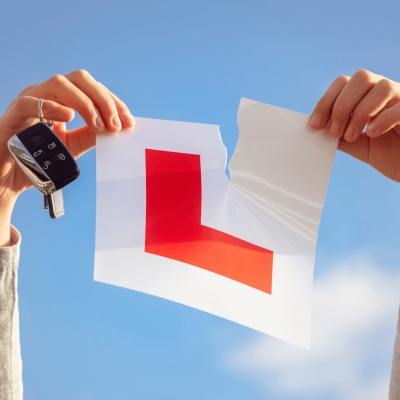Second driving test? Top tips to succeed

Failing your driving test can feel like a major setback, but you’re far from alone. In fact, more than half of learner drivers in the UK don’t pass on their first attempt. So if you’re wondering how to pass your driving test the second time around, take heart. This is your comeback moment.
Whether nerves got in the way, a few simple errors slipped through, or the unexpected caught you off guard, your first test wasn’t a failure. It was your final lesson before success. Your second attempt is a powerful opportunity to return with experience, better preparation, and a clearer, calmer mindset.
Let’s walk through everything you need to build confidence, sharpen your skills, and maximise your chances of passing the second time.
Step 1: Learn From Your First Test
After your test, you would’ve received a DL25 driving test report from your examiner. Instead of brushing it aside, treat it as a roadmap. It pinpoints exactly where things went wrong, whether it’s mirror checks, junction observations, or hesitation at roundabouts.
Ask yourself:
-
Did I pick up several minor faults in one category?
-
Was there a major fault I didn’t even notice at the time?
-
Did nerves impact my ability to focus or make decisions?
Go through the report with your instructor. They can help you turn each piece of feedback into a specific, achievable goal for your next lessons.
Step 2: Target Your Weak Spots
Once you understand where you went wrong, your practice should get focused and intentional. If junctions tripped you up, spend extra time practising different types. If it was mirror checks, make them part of your driving rhythm until they’re automatic.
Don’t just stay in familiar areas. Practice on the roads near your test centre, especially if there are tricky roundabouts, unusual road markings, or speed limit changes.
Treat your weaknesses not as failures, but as skills you’re about to master.
Step 3: Practice for Real-World Driving
It’s one thing to drive well in lessons. It’s another to stay composed when it rains, traffic builds, or something unexpected happens.
This time around, simulate real-world driving.
Practice at different times of day, including rush hour. Drive in varied weather if you can. Ask your instructor to throw in a surprise, like an emergency stop or a pedestrian stepping out unexpectedly.
The more you expose yourself to real-life scenarios, the less likely you’ll be rattled on test day.
Step 4: Master Your Manoeuvres
For many learners, manoeuvres feel like the scariest part of the test. The good news is, you only need to complete one on the day, chosen from:
-
Bay parking (forwards or reverse)
-
Parallel parking
-
Pulling up on the right and reversing
-
Emergency stop (on some tests)
Don’t aim for perfection. Aim for calm, smooth, and safe. Break each one down with your instructor. Use reference points. Practice slowly. You don’t need to impress, just demonstrate control and awareness.
Step 5: Build Test-Day Confidence
Feeling nervous is completely normal, even the second time. But confidence is a skill, and you can build it with the right preparation.
One of the best ways to feel ready is by doing a mock test with your instructor. It simulates the pressure and format of the real thing and helps you get used to performing under test conditions.
In the days leading up to the test:
-
Visualise yourself driving calmly and confidently
-
Get a good night’s sleep
-
Eat something beforehand to stay focused
-
Arrive early at the test centre to avoid rushing
If anxiety affected your first attempt, speak to your instructor. They can share breathing techniques or calming strategies to help you stay steady on the day.
Step 6: Take the Right Amount of Time Before Retesting
It’s tempting to rebook straight away and “get it over with.” But if you’re not ready, you’re just reliving the stress.
Talk honestly with your instructor. A few more lessons or a focused refresher could make all the difference.
If you want structured support, consider a short, targeted course like our 5Day Intensive Driving Course. It’s designed specifically for learners who’ve recently failed, helping you work on weaknesses and rebuild confidence quickly.
Step 7: Remember, the Examiner Wants You to Pass
It’s easy to imagine the examiner as someone waiting to catch you out, but that’s not their role. They are simply checking whether you’re safe and competent behind the wheel.
Keep these truths in mind:
-
You can still pass with up to 15 minor faults
-
One mistake doesn’t mean failure, so keep going
-
Focus on what’s ahead, not what just happened
-
Treat the test like another driving lesson and trust your preparation
Step 8: Get Inspired by Others
You’re not the only one who’s failed a driving test. Most qualified drivers have been there too.
Talk to friends or family. Chances are, they’ll tell you the same thing: failing once didn’t mean they weren’t ready. It just meant they needed a bit more experience. And you might too.
Your Second Chance Is a Stronger One
With experience, targeted practice, and a clearer mindset, your second driving test can feel like a completely different experience. Be kind to yourself. Use the feedback. Learn from your first attempt not as a failure, but as a stepping stone to success.
Whether you take a few extra lessons or boost your skills with our 5Day Intensive Course, the goal is the same. Feel prepared, drive with confidence, and get that pass.
You’ve got this. Let’s make your next test your last.
